The Best Salmon: Exploring Exceptional Quality by Country
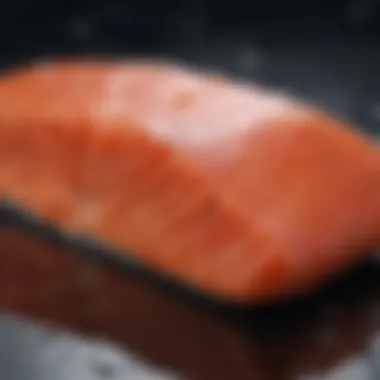
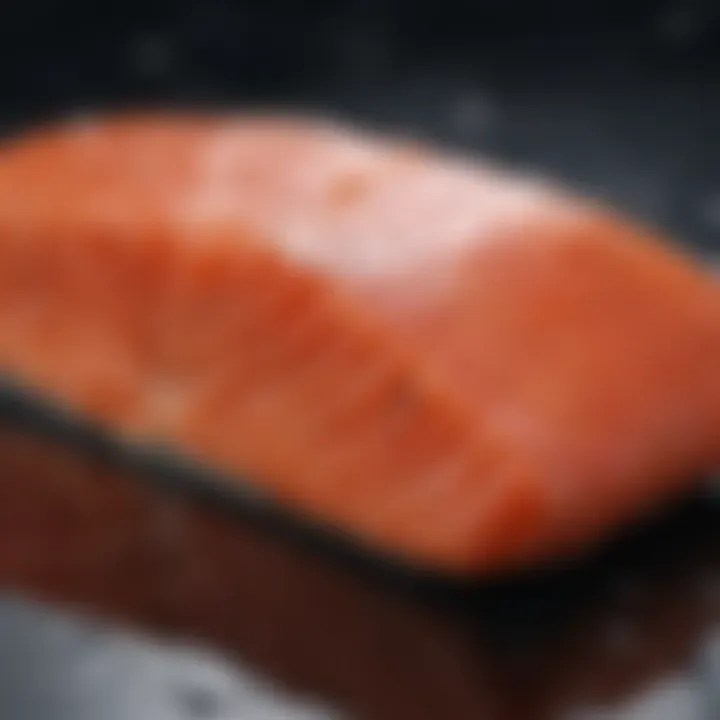
Overview of the Topic
Salmon is not just a fish; it's a phenomenon that resonates across cultures, cuisines, and ecosystems. Known for its rich flavor and high nutritional value, salmon has become a favorite among food lovers and health enthusiasts alike. However, as we explore the world of salmon, it is clear that not all salmon is created equal. The quality, taste, and sustainability of salmon heavily depend on the regions they come from and the practices employed in their cultivation and capture.
Countries like Norway, Canada, and Japan have long been associated with exceptional salmon, each bringing unique qualities and flavors to the table. The interplay of geography, climate, and human intervention plays a critical role in shaping the characteristics of salmon found in these regions.
Understanding the intricacies of salmon production isn't just beneficial for culinary appreciation; it is vital for tackling pressing environmental issues that threaten this important resource. Rising ocean temperatures, overfishing, and habitat destruction are just a few challenges facing salmon populations and their ecosystems.
Current Status and Challenges
Looking at the current landscape of salmon populations, one can’t help but notice the struggles that threaten their survival. Overfishing remains a significant concern. According to reports, particular areas, especially in the North Atlantic, have seen stocks decline drastically.
- Overfishing: The incessant demand for salmon has led to unsustainable fishing practices, pushing some species to the brink of extinction.
- Habitat Loss: Deforestation and pollution negatively impact rivers and streams where salmon breed.
- Climate Change: Rising temperatures have far-reaching effects on water quality and fish behavior.
"The health of salmon populations is often an indicator of broader environmental conditions, making them essential not just from an economic perspective, but also a ecological one."
Sustainable Solutions
In recent years, there has been a growing recognition of the need for sustainable practices in salmon production. Countries are beginning to adopt more eco-friendly methods to ensure that salmon can be harvested without depleting stocks or harming the environment.
- Aquaculture Innovations: Countries like Norway lead in developing sustainable aquaculture practices. Their focus on reducing feed waste and improving water quality has set a benchmark for the industry.
- Wild Salmon Management: Canada has implemented strict regulations on fishing practices, including seasonal restrictions and size limits to promote the reproduction of wild salmon populations.
Many organizations are showcasing successful case studies that emphasize the balance between human consumption and ecological preservation.
Impact and Importance
The implications of salmon farming and fishing practices extend far beyond the dinner plate. Ecosystems rely on healthy salmon populations for nutrient cycling and as a food source for various wildlife. Moreover, communities tied economically to salmon fishing face uncertain futures when stocks dwindle.
As environmental stewards, it is crucial to advocate for conservation efforts that protect salmon habitats for generations to come.
Preamble to Salmon Quality
Understanding what defines the quality of salmon is crucial for anyone vested in culinary arts, environmental sustainability, or simply enjoying a good meal. Salmon is not just any fish; it is a cultural icon and a staple in diets across the globe. The nuances of quality, however, range far beyond mere taste.
Quality salmon can be influenced by numerous factors such as breeding methods, environmental conditions, and culinary practices. Therefore, delineating these elements isn’t just an academic exercise but rather a necessity for those who wish to appreciate and utilize this valuable resource responsibly. Furthermore, identifying what makes salmon exceptional assists consumers in making informed decisions, ensuring that they opt for sustainably sourced and high-quality fish.
Defining Quality Salmon
When one thinks of quality salmon, aspects such as color, texture, and flavor come to mind. Quality salmon generally exhibits a rich, vibrant color—often depicted as a deep orange or bright red. This coloration is not merely for aesthetics; it signals the fish's diet and habitat. For instance, salmon that thrive in nutrient-rich waters often develop a more pronounced hue due to their natural feeding habits, as they consume krill and algae rich in carotenoids.
The texture of quality salmon also plays a significant role. A fresh, high-quality piece should feel firm to the touch, but still yield slightly under pressure. Flaky, dry slices often suggest previous freezing or inferior farming practices, which should raise red flags. On the other hand, quality salmon will have a glossy surface, showcasing its freshness and desirability.
Characteristics of Quality Salmon:
- Color: Typically vibrant orange or red, indicating a nutritious diet.
- Texture: Firm yet yielding; should not feel mushy.
- Smell: Fresh salmon has a mild, oceanic scent, while an overpowering fishy odor suggests spoilage.
- Marbling: Some salmon species, like king salmon, are known for their rich fat distribution, known as marbling, contributing to a luxurious mouthfeel and flavor depth.
Significance of Salmon in Global Cuisine
Salmon occupies a central role in a myriad of cuisines, reflecting its versatility and nutritional value. Throughout history, salmon has been more than just sustenance; it serves as a cultural touchstone in nations like Japan, Norway, and Canada. In Japan, for example, raw salmon is celebrated in sushi and sashimi, offering a raw experience rich in texture and flavor. The craftsmanship involved in preparing these dishes is paramount, showcasing the salmon’s quality through meticulous presentation and flavor pairing.
In more traditional contexts, particularly within Indigenous cultures in North America, salmon is viewed as a sacred resource, embodying significant historical and spiritual meaning. Harvesting salmon continues to be celebrated in various rituals, illustrating the deep connection between culture and natural resources. This multifaceted aspect is essential when considering how this fish fits into the broader tapestry of world cuisines.
Furthermore, the nutritional benefits of salmon cannot be overstated. It’s packed with omega-3 fatty acids, protein, and essential vitamins, earning its place in health-conscious diets worldwide. Incorporating salmon into meals allows for diverse flavor profiles and cooking techniques, making it a go-to for both gourmet chefs and home cooks alike.
"Salmon is not just a food; it’s a story wrapped in flavor, history, and culture."
In essence, the significance of salmon in global gastronomy extends beyond its taste; it intertwines with heritage, sustainability, and communal practices. This deep-rooted reverence for the fish elevates its status, making its quality a critical consideration in both culinary applications and conservation efforts.
Countries Known for Exceptional Salmon
Salmon is much more than just a fish; it holds a prominent spot on tables worldwide and reflects the culinary identity of various nations. Each country known for its salmon production brings its unique practices and traditions to the table, creating a complex web of flavors, techniques, and sustainable approaches. Understanding which countries excel in producing truly exceptional salmon is paramount for chefs, connoisseurs, and conservationists alike. The emphasis on responsible sourcing and cultural significance elevates salmon from being simply a meal to something that embodies community, heritage, and respect for nature.
Norway: A Leader in Salmon Production
Norway stands at the forefront of the salmon industry, largely due to its well-established farming practices and pristine environmental conditions. The nation’s fjords provide a near-perfect environment for salmon farming, characterized by mineral-rich waters and moderate temperatures.
Salmon Farming Practices
In Norway, salmon farming has evolved into a highly sophisticated operation that prioritizes fish health and sustainable practices. One notable element is the utilization of closed containment systems, which helps to reduce the risk of spreading diseases that often plague farmed fish.
- Key Characteristics: These systems minimize fish-to-fish contact and drastically reduce the use of antibiotics. This conscientious approach not only reduces the ecological footprint but also enhances fish quality.
- Unique Feature: Another standout practice is the stringent regulations imposed by the Norwegian government, ensuring that farming operations maintain high standards in terms of environmental and fish welfare.
- Advantages/Disadvantages: While this careful management leads to healthier fish, some critics argue it can be more costly, impacting profitability.
Environmental Conditions
The environmental conditions in Norway are distinctly advantageous for salmon farming. Cold, clear waters rich in nutrients create a natural habitat that promotes the growth of healthy salmon.
- Key Characteristics: The natural tides and currents help in oxygenating the waters, which is vital for salmon.
- Unique Feature: Additionally, Norway has invested in research to better understand these unique aquatic ecosystems, which helps inform better farming techniques.
- Advantages/Disadvantages: However, over-reliance on these favorable conditions can impact sustainability if not managed properly, as old habits die hard.
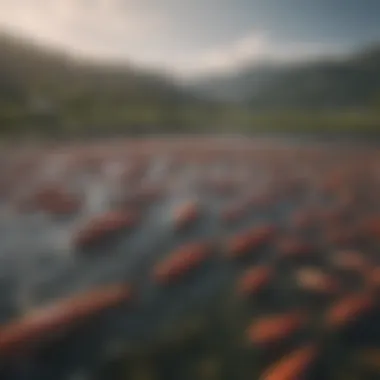
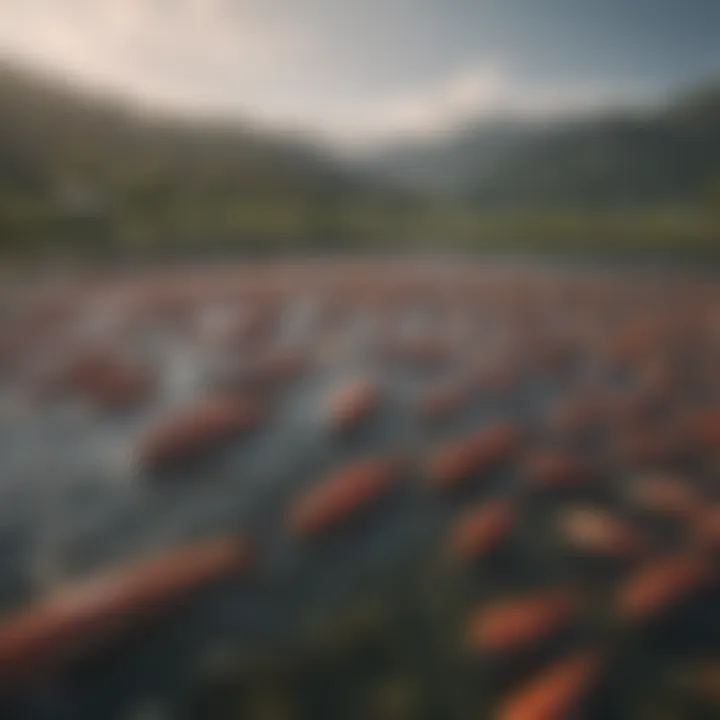
Scotland: Heritage and Craftsmanship
Scotland is not only famous for its scenic landscapes but also for its impressive craftsmanship in salmon production. With a rich cultural heritage tied to fish, Scotland effectively combines tradition and innovation in its salmon harvesting methods.
Wild vs. Farmed Salmon
In Scotland, the debate between wild and farmed salmon has sparked many conversations. Understanding the difference between the two can significantly affect perceptions of quality.
- Key Characteristics: Wild salmon, often found swimming upstream in rivers, is known for its stronger flavor and firmer texture compared to its farmed counterpart. It’s considered a delicacy, often sought after by chefs and food enthusiasts alike.
- Unique Feature: Moreover, farmed salmon has become more common, ensuring availability year-round while appealing to a different market segment.
- Advantages/Disadvantages: Each option has its pros and cons; wild salmon is harder to come by and may face seasonal limitations, while farmed salmon raises concerns over environmental impact and health benefits.
Sustainable Harvesting
Sustainable harvesting has become a cornerstone of Scotland’s salmon fishing practices, blending respect for nature with economic viability.
- Key Characteristics: The Scottish government has enforced strict quotas aimed at protecting wild salmon populations, ensuring that they remain abundant for future generations.
- Unique Feature: Traditional fishing methods, like netting, continue to be practiced in harmony with modern techniques, demonstrating a layered approach to sustainability.
- Advantages/Disadvantages: While sustainable practices protect ecosystems, they can also limit profitability in the short term, prompting producers to find a balance.
Japan: The Art of Sushi and Sashimi
Japan's relationship with salmon dates back centuries, rooted deeply in cultural traditions that showcase the fish's versatility. As salmon has adapted to various culinary applications, Japan has experienced a surge in its popularity, particularly in sushi and sashimi.
Culinary Techniques
Japanese culinary techniques are at the forefront of salmon preparation, presenting this fish in elegant and delicious forms.
- Key Characteristics: Techniques like the delicate art of slicing sashimi emphasize the freshness and quality of the salmon.
- Unique Feature: Additionally, marinating salmon in soy sauce or miso adds layers of flavor, elevating the dining experience.
- Advantages/Disadvantages: While these methods enhance taste and aesthetic appeal, they require high-quality fish, which can be hard to come by, raising concerns about overfishing.
Wild Salmon Species
Japan is home to various wild salmon species, each with distinct flavors and textures, adding depth to its culinary landscape.
- Key Characteristics: Species such as Pacific salmon, especially sockeye and chum, become prominent in regional cuisines.
- Unique Feature: Their seasonal runs inspire various cultural festivals, celebrating the catch with food and community events.
- Advantages/Disadvantages: However, reliance on wild populations may lead to sustainability issues if not managed carefully, leading to a call for responsible fishing practices.
Alaska: The Home of Wild Salmon
Alaska's pristine waters are renowned for producing some of the best wild salmon in the world, deeply intertwined with the state’s identity and economy. This region is a hotspot for salmon enthusiasts, offering a unique glimpse into the wild, untouched beauty of nature.
Run Timing and Conservation
The timing of salmon runs is crucial in understanding their lifecycle and conservation efforts.
- Key Characteristics: Salmon spawn at different times throughout the year, which influences not only the fishing season but the overall ecosystem.
- Unique Feature: Local communities have long understood these natural patterns, allowing for effective management of resources.
- Advantages/Disadvantages: Such insights facilitate conservation efforts but can clash with commercial fishing practices, prompting ongoing discussions among stakeholders.
Economics of Wild Harvesting
Harvesting wild salmon forms the backbone of Alaska’s economy, providing livelihoods for many. The commercial aspect of wild harvesting is a delicate balance between economic viability and environmental conservation.
- Key Characteristics: The economic impact is significant; quality wild salmon often fetches higher prices in local and international markets.
- Unique Feature: The Alaska Seafood Marketing Institute plays a key role in promoting sustainably sourced seafood, bolstering the state’s economic growth.
- Advantages/Disadvantages: However, overfishing and poor management can jeopardize future harvests, highlighting the need for sustainable practices.
Canada: The Diverse Ecosystems
Canada is a treasure trove of diverse ecosystems, making it an ideal home for various salmon species. The confluence of freshwater and marine habitats enhances the country's reputation for high-quality salmon production.
Freshwater and Marine Sources
In Canada, the interaction between freshwater and marine environments creates a rich habitat for salmon.
- Key Characteristics: Salmon often migrate from rivers to oceans, showcasing an incredible lifecycle that boosts local biodiversity.
- Unique Feature: This blending of habitats allows for a diverse range of salmon species, adapting to different environments, which is essential for maintaining healthy populations.
- Advantages/Disadvantages: However, changes in these habitats due to climate change raise alarms for conservationists and producers alike, demanding immediate action.
Regional Differences in Salmon Species
Canada boasts several distinct salmon species spread throughout its various regions, each with unique flavors and characteristics.
- Key Characteristics: For instance, the Sockeye salmon of British Columbia often contrasts sharply with the Atlantic salmon found on the eastern shores.
- Unique Feature: These regional specialties have fostered a culinary culture that celebrates local ingredients, influencing chefs and home cooks.
- Advantages/Disadvantages: Despite the richness this diversity offers, it can complicate conservation efforts, as different species require targeted approaches to management practices.
Factors Influencing Salmon Quality
The quality of salmon isn’t just about where it comes from; it’s a multifaceted issue tied to various factors. Understanding the elements influencing salmon quality enables enthusiasts, chefs, and conservationists alike to appreciate the nuances of this fish. Environment, breeding, and sustainable production methods all play pivotal roles in determining the flavor, texture, and overall quality of salmon. Let's break this down further.
Environmental Conditions
Temperature and Water Quality
Good salmon thrive in controlled environments. The temperature of the water is crucial—too warm or too cold can stress the fish. Salmon prefer cooler waters, generally between 10°C to 14°C (50°F to 57°F). This preference is not just a matter of comfort; it directly feeds into their growth rates and health. Cleaner water, characterized by low levels of pollutants, also leads to healthier salmon.
If the waters are contaminated, salmon can absorb toxins, which not only affects their quality but also poses risks to human consumers.
Specifically, water quality impacts the oxygen levels and nutrient availability. Water rich in oxygen allows salmon to grow better and helps in preserving their tender, flaky texture.
Habitat Preservation


Habitat preservation is like putting up fences around a prized garden—it protects the delicate ecosystems salmon rely on. Maintaining the health of rivers and coastal areas is vital. When natural habitats are threatened by urban development, pollution, or industrial activities, the consequences can ripple through the entire aquatic ecosystem.
Healthy habitats offer salmon places to spawn, feed, and hide from predators. The preservation of these areas is a beneficial choice not just for salmon but for entire biodiversity. This is especially important as wild salmon numbers are decreasing due to various human activities.
By ensuring these environments are clean and safeguarded, we support not only salmon populations, but we also sustain a vast range of marine life.
Breeding Practices
Selective Breeding Innovations
Selective breeding has taken salmon farming to a new level. Through careful selection processes, breeders enhance specific traits like growth rate, disease resistance, and even taste. This practice, while efficient, warrants a careful approach. The key characteristic of selective breeding lies in its ability to produce fish that perform well in farming environments.
However, innovation comes with a caveat; over-reliance on specific strains can lead to reduced genetic diversity. If a disease were to hit these extensively farmed populations, it could wipe them out entirely. So, while there are clear advantages in farming productivity, the potential for future risks requires foresight and balanced practices.
Influence on Flavor and Texture
Breeding also plays a significant role in the flavor and texture of salmon. Variations in fatty content ultimately lead to different taste experiences. Farmed salmon generally have a higher fat content due to controlled feeding, which might enhance flavors but can lead to a greasy mouthfeel for some.
In contrast, wild salmon often have firmer textures and are typically lower in fat. The flavor is less uniform, influenced by their diet and environment where they swim. This adds an intriguing complexity, making wild salmon a preferred choice for gourmet chefs and discerning palates.
Sustainability in Salmon Production
Farming Methods
How salmon is farmed has significant implications for its quality and the surrounding ecosystems. Methods like net pen and recirculating aquaculture systems (RAS) showcase different approaches to farming. Net pens, while traditional, can lead to overcrowding and increased waste, posing threats to local wild populations.
In contrast, RAS practices are emerging as a more sustainable choice. Though requiring higher initial investment, they minimize water use and avoid contaminating the surrounding environment. The key characteristic of innovative farming methods lies in maintaining a balance between production efficiency and environmental responsibility.
Impact on Wild Populations
The connection between farmed and wild salmon is a delicate dance. Large scale farming operations, if not managed correctly, can pose threats to wild populations. Escapees from farms can introduce disease and compete with native species, drastically altering local ecosystems.
On the upside, sustainable practices can alleviate pressure on wild stocks. For every farmed salmon consumed, there's potential for wild stocks to recover if managed rightly. It's a powerful narrative: responsible farming can be a beneficial choice as it allows us to consume salmon while ensuring wild populations can thrive.
By understanding these factors influencing salmon quality, we not only become better consumers but also stewards of the environment. In a world that demands both quality and sustainability, making informed choices about salmon production sets the course for a better future.
Culinary Aspects of Salmon
Salmon plays a significant role in the culinary world, offering diverse preparations and flavor combinations that cater to a myriad of tastes. Its rich, fatty texture and distinct flavor set it apart as a delicacy in numerous cuisines. Understanding the culinary aspects of salmon can lead to higher appreciation for this fish, especially when considering its nutritional value and versatility. Knowing how to properly prepare salmon can enhance its quality and lead to delightful gastronomic experiences.
Cooking Techniques and Preferences
Grilling and Smoking
Grilling and smoking are two of the most beloved methods to prepare salmon. Grilling produces a smoky, charred exterior that complements the natural richness of the fish, while smoking infuses it with deep flavors, often cherished in many cultures. One key characteristic of grilling is how it allows the fat to render out, giving the salmon a crisp skin and flaky interior. This method elevates its taste, making it a popular choice among health-conscious chefs who prefer cooking without added oils.
On the other hand, smoking salmon is a unique art form. Hot smoking results in a fully cooked product, while cold smoking leaves the fish raw and silky, ideal for salads or sushi. Though it requires more preparation time, smoked salmon is often regarded as a gourmet product. However, the process can lead to inconsistencies; hence, the quality of the wood used for smoking and the temperature control is vital.
"When it comes to preparing salmon, nothing beats the symphony of flavors that grilling and smoking can bring to the table."
Raw Applications
The raw applications of salmon, like sashimi or poke, emphasize the purity and quality of the fish. Serving salmon raw highlights its delicate texture and provides an unmatched experience for connoisseurs. The freshness of the fish is paramount here, as it must be handled with care to prevent any risk of foodborne illnesses.
One of the essential characteristics of raw salmon dishes is the emphasis on quality. Choosing fish that is labeled as sashimi grade ensures that the salmon meets high standards suitable for raw consumption. Sushi aficionados appreciate the subtle flavors that come from minimalistic preparation—just a touch of wasabi or soy sauce can elevate the dish. However, there can be a downside; not all salmon is fit for raw applications. It's crucial to know your sources and ensure you’re buying from reputable suppliers to avoid food safety concerns.
Pairing Salmon with Other Ingredients
Flavor Profiles and Seasoning
The use of seasonings and flavor profiles is crucial when preparing salmon. It’s remarkable how varying spices or herbs can transform the dish completely. Salmon pairs beautifully with ingredients like dill, lemon, and garlic, enhancing its savory flavor without overshadowing it. These flavors accentuate the fish's rich qualities and bring bright, aromatic notes.
A key characteristic of flavor profiles for salmon is balance. The natural oils of the fish can be complemented or cut through by acidity from citrus or vinegar. In this sense, the options are diverse—from sweet glazes using honey or maple syrup to savory marinades incorporating soy sauce or miso paste.
Another point to consider is the regional preferences that can shape the choice of seasonings. For instance, Scandinavian salmon often involves sugar curing, whereas Japanese dishes might use mirin for a sweeter touch. Each variation brings a unique texture and flavor, showing the versatility of salmon in different culinary contexts, though it may require some experimenting to find the right combinations that strike a chord.
Traditional Accompaniments
Accompaniments play a vital role in enhancing the overall salmon experience. Generally, classic sides such as roasted vegetables, creamy mashed potatoes, or zesty coleslaw complement salmon quite nicely. A popular choice is a dill sauce, which adds freshness and a tangy bite that pairs well with the oily fish.
The key here is the harmony between the salmon and its accompaniments. Dishes that combine contrasting textures and flavors tend to stand out. For example, light salads with citrus dressing can cut through the richness of the salmon, refreshing the palate. Conversely, hearty sides bring a satisfying fullness to the meal, but they might overwhelm the delicate flavors if not balanced correctly. Thus, understanding these dynamics is a central aspect of culinary exploration with salmon.
Cultural Significance of Salmon
Salmon holds a special place across various cultures, reflecting not only a source of sustenance but also a symbol of identity and heritage. From the Arctic waters to riverbanks, salmon is intertwined with traditions and beliefs. Understanding this cultural significance can enrich our appreciation of this fish beyond the dinner plate, highlighting its role as a vital resource in ecosystems and communities alike.
Historical Context
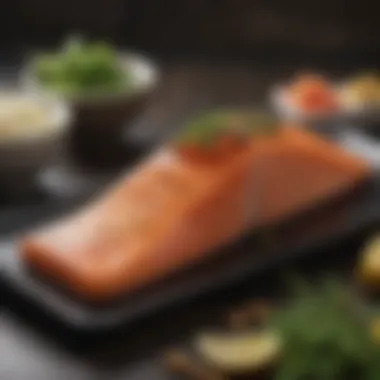
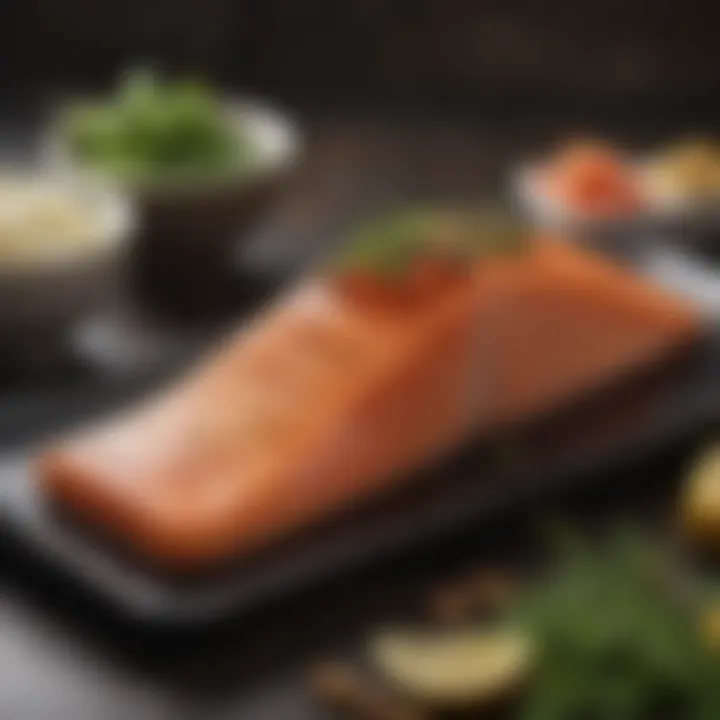
Role in Indigenous Cultures
In many Indigenous cultures, particularly those in North America and Northern Europe, salmon is more than just food; it is a cornerstone of survival and cultural identity. Among tribes like the Tlingit and Coast Salish, salmon has long been a staple, forming the basis of both their diet and economy. Many rituals celebrate the arrival of salmon, reinforcing its spiritual essence.
The unique characteristic of some tribal practices involves the belief that salmon must be honored through various ceremonies, which help maintain a balance in nature. These practices not only preserve fish populations but also create a sense of community through shared traditions. Additionally, the use of salmon in art and storytelling serves not just as means of cultural expression but also as education on sustainability and respect for natural resources.
These traditions support an identity that connects people to their land, showcasing the benefits of sustainability long before it became a global concern.
Evolving Culinary Practices
As societies evolved, so did the ways in which salmon is prepared and consumed. Modern culinary practices have embraced traditional methods but also integrate innovative techniques. For instance, while smoking and curing salmon is an age-old technique, today's chefs experiment with different spices and cooking styles that push the boundaries of flavor. The availability of salmon has broadened significantly due to global trade, which in turn has influenced culinary trends.
However, these evolving practices can lead to challenges—like overfishing and loss of local identity. Incorporating salmon into various cuisines showcases adaptability, yet culinary trends sometimes overshadow traditional methods that emphasize sustainability and community. Understanding these shifts aids in comprehension of how cultural values are maintained or transformed in today’s world.
Contemporary Perspectives
Trends in Consumption
As the global appetite for salmon grows, trends in consumption reveal shifting priorities among consumers. There’s a growing trend toward buying wild-caught over farmed salmon due to heightened awareness of environmental concerns. With salmon being marketed as a superfood rich in omega-3s, people are increasingly health-conscious about their food choices. This trend is beneficial as it drives demand for sustainable and responsible sourcing practices. On the downside, higher demand can lead to potential exploitation of fish populations if not managed properly.
Notably, culinary trends are shifting toward locally sourced ingredients, promoting the consumption of salmon from nearby waters. This reduces transportation emissions and supports local economies, ultimately fostering a connection between people and their food sources.
Impact of Globalization
Globalization tremendously impacted salmon's presence on dining tables the world over. The ease of transporting salmon across borders has made it a global delicacy. For many, enjoying sushi made with salmon feels even more accessible now, thanks to both local fisheries and global trade. However, globalization has a two-edged sword effect. While it enhances culinary diversity, it can also dilute local traditions and methods of sustainable fishing. Moreover, reliance on distant sources may weaken the community ties where cultures that revered salmon originated. As global demand rises, understanding the intricate interplay between cultural heritage and modern practices becomes essential. This balance is crucial to preserving the legacies tied to salmon and ensuring future generations continue to respect and celebrate its unique significance.
"Salmon is not just a fish; it is a bridge between the past and the future, a cultural lifeline that persists in a rapidly changing world."
Recognizing and respecting these cultural narratives enhances our connection to salmon, ensuring that it remains a cherished resource both ecologically and culturally.
Conservation Efforts and Challenges
Conservation efforts surrounding salmon are pivotal, especially in today’s ecological climate. As critical components of their ecosystems, salmon populations face numerous threats, making it essential to recognize and address these challenges. By focusing on conservation, we not only safeguard these fish but also the broader aquatic life and ecosystems they inhabit. In this section, we will explore both the threats to wild salmon populations and successful initiatives fostering conservation.
Threats to Wild Salmon Populations
Habitats at Risk
Wild salmon require clean, unpolluted water and pristine habitats to thrive. However, many of their habitats are under severe threat due to urbanization, industrial activities, and careless agricultural practices. These changes lead to poor water quality, resulting in reduced salmon populations.
A key characteristic of these habitats is their complex structure, which includes spawning grounds in rivers and streams. When these areas are damaged or altered, the chances of salmon successfully spawning diminishes. This makes it a pressing issue in conservation discussions.
The unique feature of these habitats being at risk is their role in maintaining genetic diversity among salmon populations. Healthy rivers and streams enable different salmon strains to thrive, ensuring a mixed gene pool, which can strengthen the populations against diseases. However, habitat loss often paves the road for uniformity, rendering populations vulnerable.
Climate Change Impacts
Climate change poses another ominous threat to wild salmon. The rise in global temperatures affects water temperatures in rivers and oceans. Salmon have evolved to thrive within certain temperature ranges, and any deviation from this can have dire consequences for their survival.
One crucial aspect of climate change impacts is the shifting patterns of food availability. As ocean temperatures change, the species that salmon feed on may migrate to cooler waters, disrupting the entire food chain.
The unique feature regarding climate change impacts is its deep and far-reaching nature. Whereas habitat changes may be localized, climate change influences entire ecosystems, challenging conservationists to find broad-reaching solutions. Adapting to these shifts might involve implementing innovative breeding techniques or modifying fishing practices to ensure sustainable populations.
Successful Conservation Initiatives
Community-Based Projects
Community-based projects are emerging as powerful tools in the fight for salmon conservation. Local communities often possess firsthand knowledge and a vested interest in maintaining the health of their local ecosystems. Projects focusing on habitat restoration, pollution reduction, and awareness campaigns engage local citizens, creating a sense of ownership.
The community aspect is significant because it integrates scientific knowledge with local practices, allowing for tailored solutions that fit specific regional challenges. Additionally, a community's voice can be formidable when advocating for policy changes, putting pressure on governments or industries to adopt more sustainable practices.
A unique feature of these projects is the collaboration between residents and ecological experts. Together, they share insights and strategies, fostering an educational environment that lifts the entire community.
Government Regulations
Government regulations play a critical role in salmon conservation. Enacted policies can lead to restrictions on overfishing, enforce pollution control measures, and establish protected areas to maintain habitats.
One of the most significant characteristics of these regulations is their ability to create legal frameworks for sustainable fishing. Countries have recognized the importance of salmon to their economy and culture, prompting them to take action to protect these vital species.
The unique feature here is the power of perspective. While regulations often face opposition from industries that benefit in the short term, strong guidelines put forth by the government can foster long-term ecological sustainability. Balancing economic needs and ecological health can ultimately lead to beneficial outcomes for both salmon populations and local economies.
End
Exploring the intricate universe of salmon reveals much more than just a tasty fish. It's an opportunity to reflect on quality and sustainability, two cornerstones of our seafood industry that are intertwined yet distinct in their challenges and implications. This article has journeyed through the landscapes of top salmon-producing countries, dissecting the nuances of what makes salmon exceptional. The discussion has emphasized not only the environmental factors that dictate quality, but also the socio-economic dynamics that shape the food people consume today.
Reflecting on Quality and Sustainability
Quality in salmon is not merely a matter of taste, but a complex interplay of genetics, environmental conditions, and human practices. High-quality salmon stands out, not just for its flavor but for its ability to represent a commitment to sustainability. When sourcing salmon, whether from Norway's controlled farms or Alaska's pristine waters, it's important for consumers to look beyond the surface and consider how these fish are raised, harvested, and the ethical frameworks enveloping them.
Incorporating sustainability into salmon production is about more than just adhering to regulations. It's about fostering a balance that maintains healthy fish stocks and environments. Techniques like rotational farming and integrated multi-trophic aquaculture (IMTA) come into play, allowing one species to support another while minimizing environmental degradation. By shifting focus to these sustainable practices, stakeholders can ensure a future where quality salmon remains plentiful.
"Sustainability in salmon production isn't just a buzzword; it's an imperative that affects our oceans and the future of global cuisine."
The Future of Salmon Production
As the world pivots towards more sustainable food sources, the future of salmon production hangs in the balance of innovation and tradition. Aquaculture methods are likely to evolve, embracing technology like precision farming and genetic research to create strains of salmon that grow quicker and healthier while requiring fewer resources.
Moreover, consumer preferences are shifting. People are becoming more conscious about the origins of their food, calling for transparency from producers. This is where the importance of certifications, such as the Marine Stewardship Council (MSC) and the Aquaculture Stewardship Council (ASC), can not be overstated. These labels help consumers make informed choices that reflect their values regarding environmental stewardship and wildlife conservation.
The future of salmon production is not solely a domestic issue; it’s a global conversation. Countries will need to work collaboratively in addressing overfishing, climate change, and habitat preservation. Education plays a fundamental role, empowering consumers and producers to advocate for sustainable practices and challenge industries stuck in outdated methods.
Tying back to the core of our exploration, understanding the complexities surrounding salmon production not only enhances culinary experience but strengthens our commitment to preserving marine ecosystems. Ultimately, the narrative of salmon transcends dinner plates, weaving through cultural heritage, environmental sustainability, and ethical consumption, paving the way for a more conscious future.



